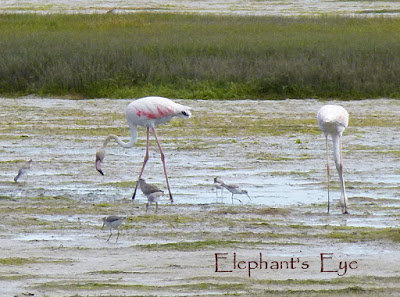Birds at the mouth of the Berg River
by Diana Studer
- gardening for
biodiversity
in Cape Town, South
Africa
When I started this False Bay blog, I trawled my Porterville blog (Elephant's Eye garden) for archived posts that were worth editing and republishing. Fast forward to my final resurrected post. From March I will fill my mid-month slot either with In A Vase on Monday with Cathy in the West Midlands, or a Dozen for Diana plant of the month.
In February 2011 we
travelled via Velddrif,
where the road crosses the mouth of the Berg River on a long low causeway like
bridge. To the mountain side and our former home is a wide salt marsh with reed
beds and mud flats, teeming with birds and there is a bird hide. To the sea
side many flat pans where brine
is evaporated in the sun to harvest salt. Flamingoes take their harvest
there too. Salt-of-the-earth
from Marie Theron, a nearby artist.
We were always in a
hurry, appointments to keep. We had passed this bird hide a dozen times, but
with half an hour free, we stopped. He took pictures. I was somewhat daunted, not
a dedicated birder. I looked out and saw birds. Every one seemed to be
different, and all unknown. Flamingoes in a huge flock across the river. Almost
close enough to touch, near the bird hide, blacksmith plovers. For the rest, I
have picked out the better pictures and ploughed thru my birdie books. Who are
you? Waders and migrants …
A pied kingfisher, 29
cm, black and white, hovered patiently, diving for lunch, then returning to its
favoured tree stump. Where it ‘beats the fish to death before eating it’. And
back to hovering over the next likely patch of water. Resting on the bank, a white
breasted cormorant, but he had his back turned to us, and was having a quiet nap.
Rednecked (but not in
breeding plumage) or little stint? If it was ‘little’ it is the smallest of the
waders and the smallest of the migrants. Flying all the way to Russia and Iran.
Head down, it feeds busily, on crustacea, mosquitoes and larvae.
Greenshank – too far
way to actually see if his shanks were green, but the shape is right, the wing
colour and the long, tip tilted bill. Migrating from the Palaearctic. Eating
insects, molluscs and crustaceans – from the surface, or wading in and probing
the sand.
Blacksmith plover (now blacksmith lapwing), one
of those distinctive birds, which even I can identify with a sigh of relief.
Black and white on long legs. This bird eats insects and worms. It likes damp
marshy places and is a newcomer (in the 1982 book!) to the South Western Cape. Related
to the wirebird on the
island of St Helena.
Familiar flamingoes
earn a big sigh of relief. Greater flamingoes, with black tipped beaks, flash
scarlet and black wings when in flight. But - Beware
of attack flamingos!
Bird books – Joy
Frandsen’s Birds of the South Western Cape 1982.
Sasol Birds of
southern Africa by Sinclair Hockey and Tarboton 1998
I invite you to join
us at Elephant's Eye on False Bay. Please subscribe as you prefer
via Feedly,
or Bloglovin,
Teal blue text is my
links.
To read comments if
you are in email or a Reader,
first click thru to the blog)
Thanks for comments
that add value. Maybe start a new thread of discussion? BTW your comment won't
appear until I've read it. No Google account? Just use Anonymous, but do leave
a link to your own blog. I would return the visit, if I could...
I welcome comments on
posts from the last 2 months.











Great photos of the birds, especially the flamingos flying...and I'm always amazed to hear of small birds flying from Russia and Iran...incredible...we have a tiny bird that flies back and forth from Japan to Australia.
ReplyDeleteAre there less birds due to the drought? Do they fly of to wetter places?
ReplyDeletePoor birds don't have a lot of choices.The Eastern and Northern Cape are also suffering from drought. They could try the nearest golf course.
DeleteThey are still irrigating golf courses?
DeleteYes - sadly - strange priorities.
DeleteBut it is borehole, or non-potable water reclaimed from the sewage works.
Not tap water. So that's alright. NOT!
Steenberg golf course uses the grey water from the associated housing estate - which is a slightly better way.
I love the wonderful birds you have. I can't wait for all of our birds to fly back in the spring. xo Laura
ReplyDeleteLike flowers, you're blessed with such a wonderful wide variety of birds. The attack flamingos were very cute.
ReplyDeleteI think it's a plover. Despite being a birder I am not too familiar with shorebirds, most look almost identical...
ReplyDeleteI've never seen flamingos in flight before. They looks so pretty and peaceful when they are standing still, but kind of scary when they are all wings and legs in the air.
ReplyDeleteLarge, beautiful and flashing pink. But a nightmare in my attack flamingoes link ;~))
Deletewonderful water birds. They all have long legs, I wonder why. Our water birds don't, I think.
ReplyDeleteWaders - long legs - shore birds - hunting for dinner in shallow water. They look like street artists on stilts.
DeleteVery enjoyable visit that gives hope of warmer days, crazy long legs on the greenshank. We're having a warm day today , give me a few more and maybe I'll dig out the camera.
ReplyDeleteHow special to see this flock of Flamingoes. What a gorgeous bird.
ReplyDeleteAmalia
xo
This was a treat to see your beautiful birds again Diana! I hope to start back with some plants for your Dozen meme.
ReplyDeleteFantastic pictures! It is so easy to rush by and not have time to notice wildlife around us. Sarah x
ReplyDelete